 7 nuclear attack submarines (SSN): B-387, 371, 467, 488, 495, 513, 517: 1972-1997
7 nuclear attack submarines (SSN): B-387, 371, 467, 488, 495, 513, 517: 1972-1997Soviet Cold War Subs
Pr.613 Whiskey | Pr.611 Zulu | Pr.615 Quebec | Pr.633 Romeo | Pr.651 Juliet | Pr.641 Foxtrot | Pr.641 buki Tango | Pr.877 KiloPr.627 kit November | Pr.659 Echo I | Pr.675 Echo II | Pr.671 Victor I | Pr.671RT Victor II | Pr.671RTMK Victor III | Pr.670/670M skat Charlie | Pr.705 lira Alfa | Pr.949 antey Oscar | Pr.945 Sierra | Pr.971 bars Akula | Pr.885 graney Yasen | Pr. 545 Laika
Pr.629 Golf | Pr.658 Hotel | Pr.667A Yankee | Pr.667B Murena Delta I | Pr.667D Delta II | Pr.667BDR Kalmar Delta III | Pr.667 BDMR delfin Delta IV | Pr. 941 akula Typhoon | Pr.995 borei Dolgorukiy | Pr.09851 Khabarovsk
VICTOR II development and story
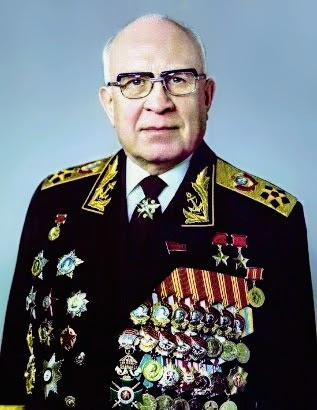 The Victor II (NATO name) were a follow-up of the Project 671, a revolution as far as SSN design went in USSR. These are largely considered as the second generation SSN, and in numbers the bedrock of the underwater nuclear-powered attack force until the fall of USSR, even afterwards and until recent years. The base program was for an advanced submarine with a modified albacore-type teardrop shape, small, well streamlined conning tower. According to some sources surface displacement was initially of 3,650 tons while others sources went as far as 4,300 tons for an underwater displacement ranged from 4,830 to 5,100 tons. Admiral Sergei Kuznetsov (photo) was instrumental in the development of Project 671.
The Victor II (NATO name) were a follow-up of the Project 671, a revolution as far as SSN design went in USSR. These are largely considered as the second generation SSN, and in numbers the bedrock of the underwater nuclear-powered attack force until the fall of USSR, even afterwards and until recent years. The base program was for an advanced submarine with a modified albacore-type teardrop shape, small, well streamlined conning tower. According to some sources surface displacement was initially of 3,650 tons while others sources went as far as 4,300 tons for an underwater displacement ranged from 4,830 to 5,100 tons. Admiral Sergei Kuznetsov (photo) was instrumental in the development of Project 671.
Director Principles
Despite a certain “anti-submarine” specialization, the “cruiser submarines” of Project 671 (VICTOR) were nevertheless multi-purpose ships, designed to fight enemy surface ships as well. The most important and difficult targets were the US attack aircraft carriers. In order to sink these post-war supercarriers, it was necessary to hit them with a dozens of 533 mm torpedoes or use “special” (tactical nuke) ammunition which was not always possible for political reasons. And the improvement of NATO ASW cover in the combat carrier group, and widespread use of anti-submarine helicopters, plus the introduction of new high-power sonars and in particular towed variable-depth sonars (VDS) and anti-submarine guided missiles such as ASROC, “Ikara” or “Marathon”, required for the Soviet naval command a radical increase in the range and speed of torpedoes.

In order to expand the capabilities of the Project 671 subs, primarily aircraft carriers and their escort, in November 1961 already a joint decision was made by the Navy and the Ministry of Shipbuilding Industry to strengthen the torpedo armament by releasing a new super-heavy, very long-range torpedo, the SET 65-73 with a caliber of 650 mm. One or two were though enough to completely disable a large warship with the use of a powerful nuclear warhead further increasing their potential. Another important feature was their ability to cover a 50-kilometer distance at an average speed of 50 knots, which to date, was a unique capability. To accommodate the new large-sized torpedo on board it was necessary to make a number of changes to the design, in particular, increase the length of the torpedo compartment. However, due to the increase in size of the compartment and large length of the new torpedoes and preserve buoyancy, it was necessary to install a sealed horizontal platform dividing the first torpedo compartment into two. Later was added another capability using these new tubes, the “Vyuga” ASW missile (see later).
An enlarged Project 671
They were 15 meters shorter than the earlier November class, 1 meter wide, but their hull design differed significantly from their contemporary American counterparts, retaining a double-hull whereas after the Skipjack class, the US command decided to switch to a single-hull layout. The Soviet decision reflected the will to accept an increased weight, higher noise and potential lower speed in exchange for extra safety in peacetime or in wartime. The evolution was constant, leading to three separate classes, under the same Project 671 programme over the years, with the VICTOR I and II relatively similar and a larger Victor III Projekt 671RTM between 1967 and 1977 so over ten years. The displacement increase was above 1,000 tons for an extra section from 89 to 107.1 meters long and 8 meters wide instead of 7.2m for more torpedoes.
Project 671RT Syomga was an in-between, incorporated many solutions to early issues found with the design, after the first initial series were completed. The Malakhit bureau essentially enlarged the design was enlarged with the Sjomga (“noble salmon”). They were extended by 9.3 meters, with the pressure hull enlarged by by 0.5 meters for an an increased displacement (4,500/5,900 tons) to accommodate two larger 650 mm torpedo tubes and extra spare torpedoes. This increased size led to a decrease of the top speed to 30 knots, albeit on trials, 31.7 knots were obtained.
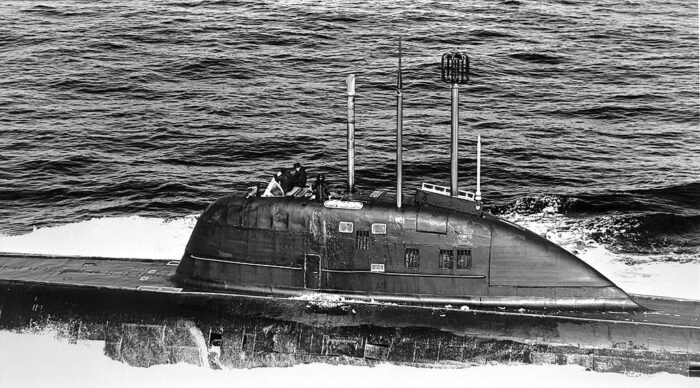
The forward part of the hull was the one benefiting by this enlargement, for a new weapon system and larger sonar but also with some silencing measures. The biggest difference was that two of the six 533 mm torpedo tubes were replaced with 650 mm tubes, enabling the use of the “super-heavy” SET 65-76 torpedoes. The final result was eighteen 533 mm torpedoes and six 650 mm torpedoes. The tubes also enabled encapsulated missiles RPK-2 Vyuga for the first time, which enable a ship strike at ranges from 10 to 42 km.
The increase in displacement by 750 m3 compared to the previous boats enabled to increase the volume of the pressure hull in the central post and forward compartment for additional ammunition but the new sonar system was radically improved to the MGK-300T Rubin and an updated Ladoga combat information and control system. Much efforts were made in soundproofing as well as the VICTOR II for the first time in the Sovit sub fleet, introduced “rafting” in the powerplant, helped by its location n a single compartment and larger internal volume. Suspenser system could be installed around the original powerplant thanks to this supplementary 25 cm space either side. Trials showed these measures indeed significantly reduced the noise generated by the engine room.
To further reduce their acoustic signature, the turbine gearbox and turbogenerators with all their mechanisms were placed on a single frame, with a shock-absorbing base. When first at sea, they baffled the US intel community. In the end, it was assessed their noise level was comparable to 5-year-older Sturgeon-class, which showed a clear catching up with western tech. But again, with a double hull, at top speed, the noise level increase significantly.
Unlike their predecessors, the VICTOR II were all built at Krasnoye Sormovo shipyard in Gorky. The keel of the lead boat, K-387, was laid on April 2, 1971, but slow pace meant in 1974 construction also started at the more experienced Leningrad yard, with three ships built there and a total of 7 units only. Production was terminated indeed in order to build the next Project 671RTM (VICTOR III) far more promising. The latter were built indeed from 1977 to the fall of the USSR. They were discarded in 1993-97 due to tke lack of funding for a major overhaul and modernization. The Victor III were just more promising.
Design of the class
In order to expand the combat capabilities of Project 671 Yersh submarines in combating surface ships (primarily enemy attack aircraft carriers), in November 1961, a joint decision was made by the Navy and the Ministry of Shipbuilding Industry to strengthen the torpedo armament by equipping the submarines with new super-powerful long-range torpedoes with a caliber of 650 mm. One or two such torpedoes could completely disable a large warship (aircraft carrier or battleship). The use of a powerful nuclear warhead further increased the potential of this weapon. Another important feature of large-caliber torpedoes was their ability to cover a 50-kilometer distance at an average speed of 50 knots. To accommodate the new large-sized weapons on board the Project 671 Yersh submarine, it was necessary to make a number of changes to the ship’s design, in particular, an increase in the length of the torpedo compartment. Another important innovation in the armament system of the modernized ship was its equipping with the RPK-2 Vyuga anti-submarine missile system.
In 1963, the design of the modernized nuclear submarine “671RT Semga” began. On July 15, 1967, the technical documentation for the ship was approved. Compared to the nuclear submarine of project 671 Yersh, the submarines of project “671RT Semga” also slightly changed the arrangement of the compartments of the pressure hull:
1st- torpedo tubes and ammunition, living quarters and provisions;
2nd- cabins, wardrooms, galley and DUK (a special system for throwing garbage overboard the boat);
3rd— central post, provisions and auxiliary mechanisms;
4th— reactors;
5th— GTZA-ATG block, desalination plant and power plant post;
6th— compressors, steam jet refrigeration units, PR-501-2 converters;
7th— living quarters, diesel generator;
8th— propulsion electric motors, rudder drives, galley, chemical post.
It was decided to build submarines of the 671RT Semga project in Gorky, at the Krasnoye Sormovo plant. In 1971, the construction of the 671RT Semga submarine began at the Admiralty shipyard in Leningrad (which was explained by the insufficiently high pace of work in Nizhny). The Leningrad bureau made a number of improvements ship construction techn as instead of the block method, a more advanced unit-block method was used with frames having with already pre-mounted units weighing up to 350 tons, then pushed into the section for full assembly.
Hull and general design
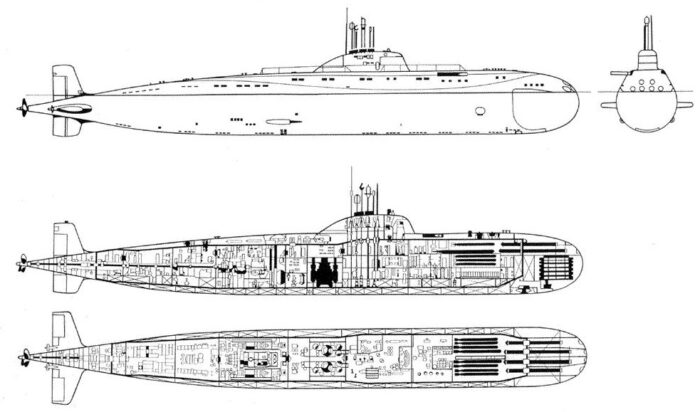
The VICTOR II kept the same twin-hull configuration, with a pressure hull divided into seven compartments (torpedo/sleeping/battery compartment, command center, reactor compartment, turbine compartment, auxiliary equipment compartment, sleeping compartment and diesel generator compartment, and electric motor compartment). Ballast tanks being located along the ship and at the stern and bow. Like the previous boats, they could dive to 400 m thanks to their thicker pressure hull.
Being the first also to use a single-screw propulsion system to reduce noise levels, displacement, increase speed was initially only granted by the Commander-in-Chief of the Fleet “on an exceptional basis”.
2 — antenna of the Arfa-M sonar (mine detection)
3 — 533-mm TA; 4 — 650-mm TA
5 — torpedo loading hatch
6 — bow (torpedo) compartment
7 — bow emergency buoy
8 — bow hatch
9 — enclosure for spare torpedoes and quick-loading device
10 — spare 533-mm torpedo
11 — spare 650-mm torpedo
12 — tank for bubble-less torpedo firing
13 — bow trim tank
14 — equipment enclosure for control devices for the Ladoga 1V-671RT missile-torpedo and torpedo firing and the Rubin sonar
15 — AB
16 — bow trim tank
18 — central battery
19 — second (living) compartment
20 — third (central post) compartment
21 — antennas of the Rubin sonar
22 — navigating bridge
23 — PZNG-10M periscope
24 — periscope of the MT-70-10 complex
25 — PMU antennas of the Zaliv-P SORS
26 — PMU antennas of the Kaskad radar;
27 — PMU antennas of the Zavesa radio direction finder
28 — PMU antennas of the Kiparis (KSS Molniya)
29 — strong wheelhouse
30 — central post
31 — enclosures of electronic weapons and acoustics
32 — partitions of auxiliary equipment and general ship systems (bilge pumps, general ship hydraulic system pumps, converters and air conditioners)
33 — fourth (reactor) compartment
35 — fifth (turbine) compartment
36 — steam turbine
37 — planetary gearbox
38 — main thrust bearing
39 — condenser
40 — sixth (electromechanical and auxiliary equipment) compartment
41 — aft hatch
42 — aft emergency buoy
43 — high-pressure water pressure system compressors
44 — seventh (living) compartment
45 — eighth (propulsion motor and steering drives) compartment
46 — aft trim tank
47 — horizontal rudder drives
48 – vertical stabilizers.
The same 4.5 meters propeller placed behind the control surfaces of the rudders was kept, as well as the small twin screws in gondolas on the aft control surfaces as extra safety, despite being prone to damage. They also improved their agility in ports and restricted waters by 30% and allowed a turbine transmission with two independent turbogenerators to be located in a single compartment along with all auxiliary systems and highly automated, reducing the overall lenght, although not as radically on the Alfa class. Still, despite being shorter, Project 671 boats had a 30% greater displacement compared to Project 627A (November). Project 671RT managed to keep the same powerplant, and keep a top speed of 31 knots versus 30 knots on Project 627 boats, but at great noise, still.
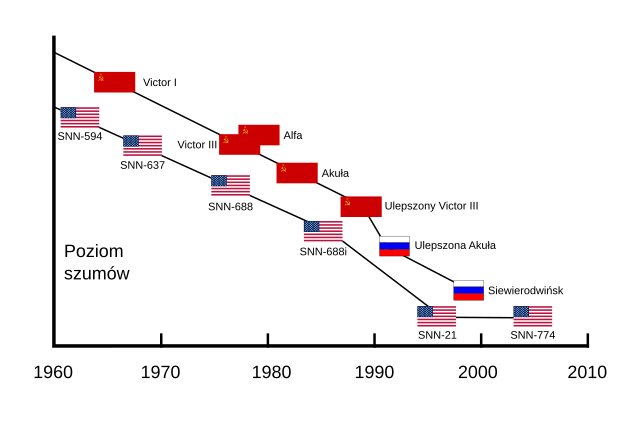
Comparison of noise levels of Project 671 ships with other types of ships; SSN-594: Thresher; SSN-637: Sturgeon; SSN-688: Los Angeles; SSN-688i: Improved Los Angeles; SSN-21: Seawolf; SSN-774: Virginia versus Victor: 671; Alpha: 705; Victor III: 671RTM; Akula: 971; Improved Victor III: 671RTMK; Improved Akula: 971U; Severodvinsk: 855.
Powerplant
During the project modernization, some technical elements of the submarine’s power plant were also changed. Due to the need to further reduce the acoustic field, the turbo-gear unit and autonomous turbogenerators with service mechanisms were installed on a common frame in a single unit with a two-cascade shock-absorbing mount. Instead of a 200 kW DC diesel generator, the boat received a more powerful 460 kW diesel generator. During forced cooling of the steam-generating plant on both sides at sea, this ensured movement under the propulsion electric motors or recharging of the batteries in the underwater periscope position.
Since the main source of noise designer N.P. Bykov, suggested to install the turbines and gearbox on a new frame which in turn, was secured to an intermediate frame for a two-stage shock absorption system. The turbine compartment had to be increased later due to the limited space provided by this innovation on the VICTOR III. Instead of a 200 kW DC diesel generator, they received a more powerful 460 kW diesel generator. When the steam-generating plant on both sides was forced to cool down at sea, this ensured that the boat could run under the electric propulsion motors or recharge the batteries in the underwater periscope position.
There was one VM-4P pressurized-water twin nuclear reactor (2×75 MW), with two sets OK-300 steam turbines drivng the same 7-bladed propeller plus auxiliary 4-bladed props for 31,000 shp (23,000 kW) at 290 shaft rpm, and 2 low-speed electric cruise motors and the 2 small props on stern planes powered at 1,020 shp (760 kW) at 500 rpm. The Electric units delivered 4,460 kw tottal thanks tp two 2,000-kw, 380-V, 50-Hz a.c. OK-2 turbogenerators, and a backup 460-kw diesel emergency set. Accepted top Speed figure was 30 knots.
Armament
SET 65-73 650 mm Torpedoes
In Service by 1973 these monster torpedoes weighted 8,820+ lbs. (4,000+ kg) for an overall Length of 433 in (11.000 m), optional nuclear warhead, range and Speed of 54,700 yards (50,000 m) at 50 knots, powerted by a Kerosene-Hydrogen Peroxide Turbine. The model was a straight course, non-homing torpedo. It was designed for sunk an aircraft carrier or a coastal targets with a single torpedo.
In 1976 was introduced the improved 65-76 “Kit” (Whale). It was the non-nuclear version, carrying a conventional 992 lbs. (450+ kg) payload, but otherwise identical. It was however a wake following torpedo for more precision. The SSGN Kursk is believed to have exploded because of the leaking SET 65-76.
These were very costly torpedoes, no more models were designed of such caliber afterwards.
Vyuga 53/65
Another important innovation in the armament system of the modernized ship was its anti-submarine missile system “Vyuga”, the development of which was carried out since 1960 at the Sverdlovsk OKB-9 Uralmashzavod under the leadership of chief designers F. F. Petrov and N. G. Kostrulin. The missile included in the system was to be fired from submarine TA at a depth of 50-60 m, took off, flying along a ballistic trajectory, to deliver a tactical nuclear charge to the target area. It was envisaged to create missiles with a caliber of 533 and 650 mm (“Vyuga-53” and “Vyuga-65”). On August 4, 1969, by government decree No. 617-209, the Vyuga system with the 81R (533 mm) missile was accepted into service with the Navy.
It could hit underwater targets at ranges of 10-40 km. It should be noted that the American analogue, the UUM-44A SUBROC, started developement in 1958 and was accepted into service in 1965. Compared to the Soviet system, it had a slightly greater maximum firing range (about 50 km), which was due to the greater
range of the American Raytheon sonar system AN/BQQ-2 compared to the domestic Rubin sonar.
Sensors
The ship received a slightly improved GAK MGK-ZOOT “Rubin”. The combat capabilities of the boat were significantly increased due to its equipping with the combat information and control system “Akkord”. The ship was also equipped with a number of other new or modernized systems, as well as a new radio communication complex “Molniya”. In the compartment of the light hull behind the wheelhouse, a towed communication antenna of the Paravan system was placed, providing reception of ultra-long waves at a depth of up to 160 m.
The boats were also equipped with a number of other new or modernized systems, as well as a new radio communication system “Molniya”. In the compartment of the light hull behind the wheelhouse, a towed communication antenna of the “Paravan” system was located, which made it possible to receive radio transmissions in the VLF range while underwater. During the mid-life repairs on the submarine of project 671RT, the “Rubin” sonar system was replaced with the “Rubicon” sonar system, and the “Kaskad” radar system was replaced with the “Albatros” radar system with the “Korma” attachment.

VICTOR II rendition by Mike1979Russia
⚙ VICTOR II specifications |
|
| Displacement | 4500t surfaced /5700t submerged |
| Dimensions | 102 x 10 x 7m (334ft 6in x 32ft 10in x 23ft) |
| Propulsion | As VICTOR I |
| Speed | 31 kts trials, 30 kts service |
| Range | Unlimited but for food |
| Armament | 2x 650mm TTs, 4x 533 mm TTs, 16 torpedoes |
| Sensors | See notes |
| Crew | 20 officers, 80 crew |
Victor II Career
Priject 671RT were considered a success. The advantages were many: New torpedo and missile-torpedo in 533 and 650 mm cal87iber giving unprecedented flexibility, radical noise reduction in almost the entire frequency range. The state decided to award the implicated design bureau, Admiralty Plant and contractors orders and medals, while the State Prize was awarded to the chief designer G.N. Chernyshev, and his deputy V.D. Levashov as well as chief designer for armament L.A. Podvyaznikov.
These boats entered the Northern Fleet, and were based in Gremikha and Bolshaya Lopatka. They carried out very intensive combat service (to Soviet standards) and each carried out from 6-12 patrols to the Atlantic and Mediterranean. None of the VICTOR II, unlike the others, was implicated in a serious incident, at least officially as far as declassified records goes.
 K-387 (1972)
K-387 (1972)
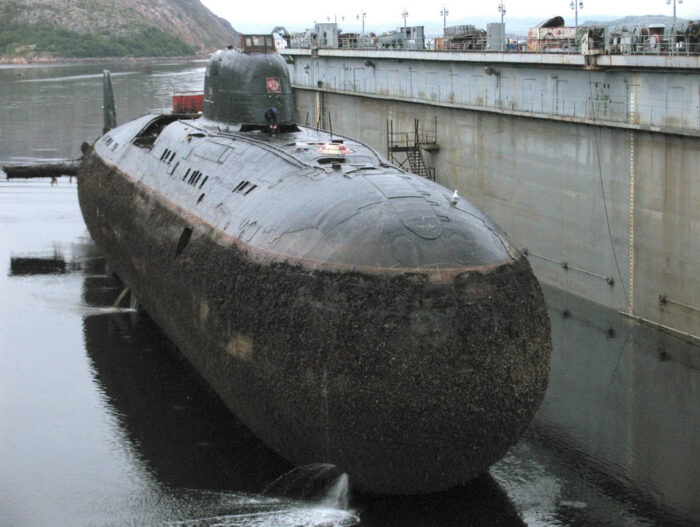
Project 671RT Syomga/Victor II class boat SSN in drydock, crusty !!! (reddit)
K-387 (from 1992 B-387) was laid down at the slipway 801 at Krasnoe Sormovo, Gorkiy on 2.4.1971. She was launched on 2.9.1972 and completed on 30.12.1972.
“9.72 transferred to Severodvinsk, via inland rivers, for fitting out; from 31.1.73 attached to the 3rd Submarine Division; from 15.3.74 attached to the 33rd Submarine Division; 1974 operational tour; 1.76 began 2nd operational tour, but had to return early due to a rupture of the main condenser; 5.7.77 reclassifed as BPL; 1977 operational tour; 3.79 to 5.79 operational tour in the North Atlantic; 1.7 to 10.7.81 took part in the “Sever-81” exercise; 1982 operational tour (65 days); from 25.5.82 attached to the 6th Submarine Division; 1.3.83 to 30.12.87 repairs and overhaul at SRZ Nerpa, Vyuzhnyy; from 12.85 attached to the 24th Submarine Division; 7.88 to 9.88 operational tour in the Atlantic and Mediterranean; 8.90 to 10.90 operational tour in the Atlantic and Mediterranean; from 1.91 attached to the 17th Submarine Division; 8.91 to 10.91 operational tour; 1992 operational tour; 3.6.92 reclassified as a ABPL, and renamed B-387; from 1993 attached to the 3rd Submarine Division; 4.9.95 decomissioned – transferred to Gremikha (285th independent Submarine Battalion); 2002 towed to SRZ-10, Polyarnyy; 3.2005 reactor removed
 K-371 (1974)
K-371 (1974)
К-371 (from 6.1992 B-371) was from yard 802, Krasnoe Sormovo, Gorkiy, laid down on 27.2.1973, launched on 30.7.1974 and completed on 30.9.1974.
In August 1974 she was transferred to Severodvinsk via inland rivers, for fitting out and from 7 November 1974 attached to the 33rd Submarine Division. First patrol in 1975, same 1976, 1979 (Norwegian Sea, 12 days under ice). She returned early due to reactor cooling problems. Patrol in 1980, Greenland Sea. 1981 Norwegian and Barents Seas. From May to December 1981 she was in overhaul at SRZ-10 (Polyarnyy) and from 25 May 1982 attached to the 6th Submarine Division. From July 1982 to Sept. she had a patrol, same 1983 but in the Arctic and in 1983, from August to October, in the Mediterranean. Drom 11 May 1982 she was attached to the 24th Submarine Division. From 27 January 1989 she started a major overhaul at SRZ-10 in Polyarnyy. She was moored at the naval shipyard Shkval in Polyarny. Due to a lack of funds, necessary repairs and maintenance have not been carried out. The submarine has not been officially decommissioned, but it is not expected that it will actually be repaired. The naval yard’s principal responsibility is to keep the vessel afloat and to ensure necessary fire safety precautions. She is now presumed scrapped.
 K-467 (1976)
K-467 (1976)

К-467 (6.1992: B-467) was laid down at yard 803, Krasnoe Sormovo, Gorkiy on 19.11.1974, launched on 7.5.1976 and completed on 30.11.1976. In September 1976 she was transferred to Severodvinsk via inland rivers for fitting out. In December she joined the 33rd Submarine Division made a first shakedown and patrol in 1978 with the “Magistral” and “Evolyutsiya” exercises. In July 1977 she was reclassifed and in 1979 made another patrol. In Janruary to March 1980 she took part in the “Eskiz” and “Svet-80” exercises. This summer she took part in the “Atlantik-80” exercis with K-513. On 1-10 July 1981 she took part in the Sever-81 exercise and made a 85 days, then a 1982 operational tour of 197 days with a change of crew overseas. From 25 may 1982 she was assigned to the 6th Submarine Division. In the summer 1982 she made a serie of tests in the Arctic with K-447. In 1985 she made a long patrol in the Mediterranean. From October she joined the 24th Submarine Division. From December 19582 to June 1986 she had an overhaul at SRZ-10 in Polyarnyy. In 1987 she made a tour in the South Atlantic and Mediterranean and in April 1989 she took part in an exercise in the Barents Sea. In 1989 she made a long patrol and from late 1989 she started a major mid-life overhaul at SRZ Nerpa in Vyuzhnyy which was never completed due to the lack of funding in post-USSR Russia. She was decomissioned on 8 Sept. 1997 and on 3 June 1992 reclassified, renamed B-467. She was stricken in September 1997. In 1998-2000 her reactor was removed. In total she made nine patrols.
 K-488 (1977)
K-488 (1977)
К-488 (6.1992: B-488) was laid down at yard 804, Krasnoe Sormovo, Gorkiy on 15.12.1976, launched on 8.10.1977 and completed on 29.9.1978.
Like the others she was transferred via inland rivers for fitting out and in 1978 joined the 33rd Submarine Division. First patrol in 1979, Indian Ocean and Arabian Sea over 180 days. Same in 1980 with a crew swap at sea and in 1982 a 67 days patrol, in 1983 76 days. From 18 july to 11 December 1984 she was in overhaul at SRZ Nerpa in Vyuzhnyy. From 29 May to 1 July 1985 she took part in operation “Aport”, North Atlantic-Newfoundland. From October 1985 she was attached to the 24th Submarine Division and in 1988 to the 17th Submarine Division. From 20 September 1989 she started her major overhaul at SRZ Nerpa, never completed (lack of funding). In 1992 she was renamed B-488, was decommissioned on 30 June and on 6 June 2001 transferred to SRZ-10 in Polyarnyy to have her reactor removed. She was stricken in June 1993, Now scrapped.
 K-495 (1975)
K-495 (1975)
К-495 (6.1992: B-495) was from yard 01621 at Admiralty in Leningrad laid down on 28.9.1974, launched on 26.8.1975 and commissioned on 31.12.1975. She transferred to Severodvinsk via inland rivers for fitting out in between. In Feb. 1976 she was attached to the 33rd Submarine Division and between July and August took part in the 16th Scientific Expedition to Greenland and the Barents Sea. In 1976 she made a patrols in the Atlantic Ocean and tested the VA-111 Shkval torpedo missile. In 1977 she made another patrol as well as 1978, 1979. From 30 May to 17 August 1980 she was part of another scientific expedition with under Arctic ice cruise. In 1981 she made her longest patrol so far (67 days). From 1981 to December 1982 she was overhauled at Nerpa Yard in Vyuzhny. From 25 May 82 she was attached to the 6th Submarine Division. From 27 March to 15 June 1984 she made n Atlantic patrol. From April 1984 she joined TK-208 in the Kara Sea and from December 1985 she was attached to the 24th Submarine Division. In 1987 she had another patrol. From 1 August 1990 she attached to the 17th Submarine Division and from 3 june 1992 reclassified B-495. On 17 February 1993 she started an overhaul at SRZ-10 in Polyarnyy and was decommissioned on 30 june 1993 decomissioned due to lack of funding, to complete the overhaul. From 1 July 1996 she remained attached to the 346th Submarine Battalion, transferred to Guba Ura and in 2004/2006 her reactor compartment was removed at SRZ-10 in Polyarnyy.
 K-513 (1976)
K-513 (1976)
К-513 (6.1992 B-513) was laid down at yard 01625, Admiralty, Leningrad on 22.7.1975, launched on 21.8.1976 and commissioned on 27.12.1976.
K-513 was transferred via inland for fitting out and in 1976 joined the 33rd Submarine Division. First patrol in 1977, Atlantic and Mediterranean and tests off her newly installed Sonar “Rubin” for the next Victor III class. Patrol in 1978 as well as from 24 August to 8 September 1979, escorting K-320 on her way to the Pacific. While surfaced at the North Pole on 1st September, she collided with underwater iceberg but suffered no damage. On 16-20 April 1980 she took part in a local exercise and in the summer to the command staff exercise “Atlantik-80” with K-467. In April-August she was in patrol the Red Sea and Indian Ocean (port calls Mabuto, Aden, Dahlak, and changed crews there via Ivan Rogov).
In 1981 she patrolled for 62 days and in 1982 was in the Indian Ocean for 87 days (port called Luanda 11 days) and also stopped to operate off the RN base on Ascension Island as the Falkland war rages on. On her way back she teamed up with Akademik Vavilov off Iceland. In 1983 she made two patrols of 87 days and 72 days and in 1984 started her overhaul at SRZ-10 in Polyarnyy until 3 January 1986. In between in 1985 she was versed to the 24th Submarine Division and maded a first patrol from 15 May to 12 July 1986 inclusing the Arctic ice.
She had another refot in March-April 1987 at SRZ-10 and was on patrol from 29 April to 1 July. In 1989 she joined the 17th Submarine Division and started a short overhaul in 1990 at SRZ-10. In 1991 she made her last patrol. In June 1992 she was reclassified, renamed B-513 and from 1993 joined the 3rd Submarine Division but was no longer active due to funds lacking, decommissioned on 30 June that year. She was stricken no long after. She was in reserve a the 285th independent Submarine Battalion and from 2003 transferred to the Nerpa Yard for dismantling with her reactor extracted in 2003-2004.
 K-517 (1978)
K-517 (1978)
К-517 (6.1992: B-517) was laid down at yard 01627 at Admiralty in Leningrad on 23.3.1977, launched on 24.8.1978 and completed on 31.12.1978.
In January 1979 she was attached to the 33rd Submarine Division and her first patrol of 7 months was in the Indian Ocean 1980-81. She swapped crews on 5 October 1980 and in July-August 1981 had pressure tests. From the 18 of August until 22 October she made another patrol, initial escorting K-506 to the Pacific Fleet. She reached the North Pole on 1st September 1981 and from April to May 1982 she cruised in the Atlantic and Mediterranean over 67 days then Mediterranean again in 1983 and a venture into the Beaufort Sea over 43 days. In 1983 she made another patrol over 33 days and in 1984 two months in the Mediterranean. From 1985 she was versed to the 24th Submarine Division and started her overhaul on 9 October 1986 to 12 February 1987 in Polyarnyy. She made a short patrol in 1987 with K-358 under the Arctic and teamed with the research ship “Deviator”. After a refit in 1989 at SRZ-10, she saw no more service, but was attached in 1990 the 17th Submarine Division. She made a patrol that year over 80 days and from June to August 1991 made another Mediterranean patrol of 80 days. From 3 June 1992 she was reclassified, renamed B-517, in 1993 attached to the 3rd Submarine Division, decommissioned in June and stricken due to lack of funding in reserved with the 285th independent Submarine Battalion in 1994. She was gradually dismantled from 2001 and in June transferred to Severodvinsk to have her reactor removed in 2005. Now scrapped.
 K-505 (BU slip)
K-505 (BU slip)
K-505 was ordered to Krasnoye Sormova, Gorkiy (serial no. 805) and laid down in January 1975 but all work was stopped on 11.6.75. She was cancelled and later scrapped on slip.
Gallery
From Hazegray (src below)
Read More/Src
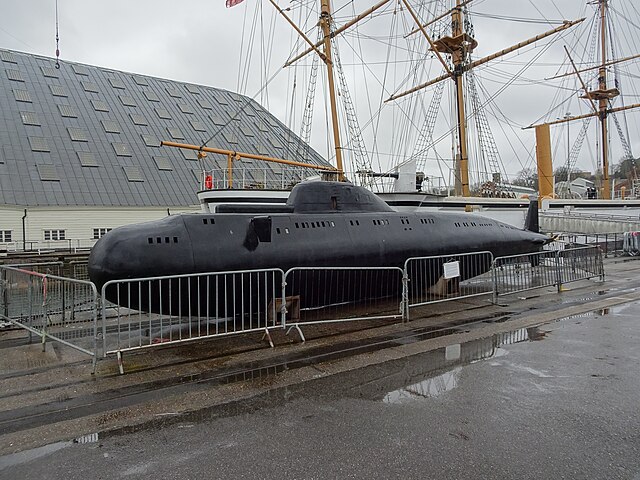
Model of a Victor III used for a bond movie, Chatham Dockyard.
Links
https://web.archive.org/web/20080206173451/http://ship.bsu.by/main.asp?id=101090
nationalinterest.org/ russias-victor-ii-class
nationalinterest.org failure or stepping stone victor-ii
https://www.globalsecurity.org/military/world/russia/671.htm
http://www.navweaps.com/Weapons/WTRussian_post-WWII.php
http://spb.org.ru/bellona/ehome/russia/nfl/671rt.htm
https://www.hazegray.org/features/russia/ssn.htm
https://web.archive.org/web/20141219205723/http://www.deepstorm.ru/DeepStorm.files/45-92/nts/671RT/list.htm
view-source:https://web.archive.org/web/20141219205723/http://www.deepstorm.ru/DeepStorm.files/45-92/nts/671RT/list.htm
Victor-class Submarine: The Soviet Union’s Primary Attack Submarine
http://www.ww2.dk/new/navy/victor%202.htm
Videos
Model Kits
on www.scalemates.com
Ex: Project 671RT Syomga Victor II Class Submarine by Polar Bear 1:350. OKB Grigorov 1:700.

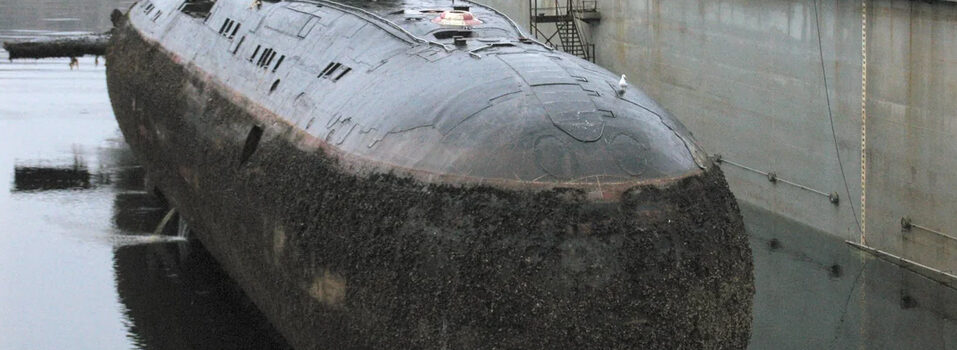

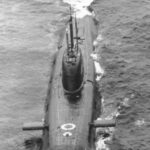
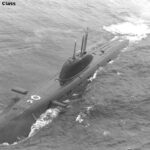
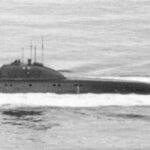

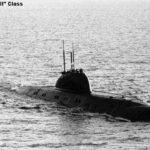
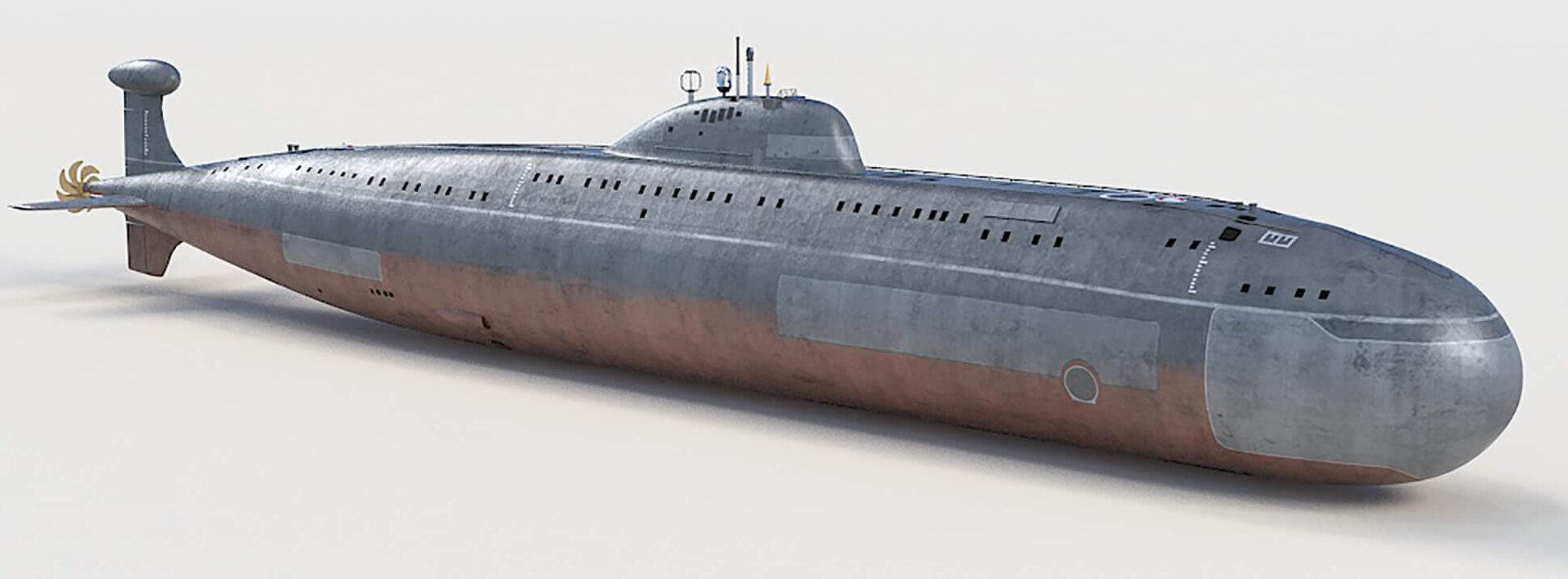
 Latest Facebook Entry -
Latest Facebook Entry -  X(Tweeter) Naval Encyclopedia's deck archive
X(Tweeter) Naval Encyclopedia's deck archive Instagram (@navalencyc)
Instagram (@navalencyc)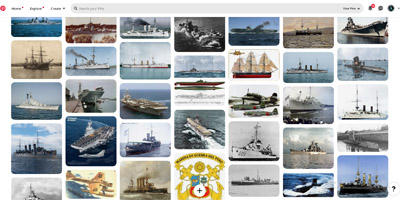

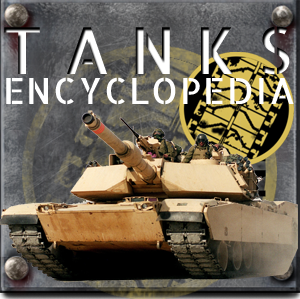
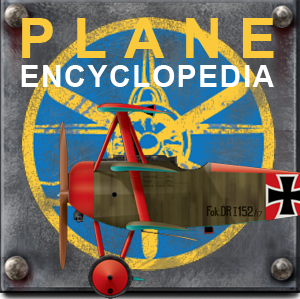
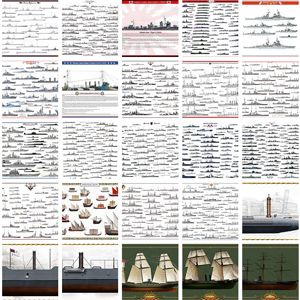
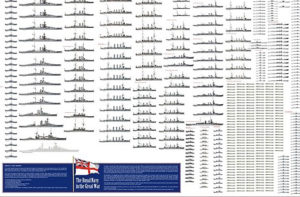
 French Navy
French Navy Royal Navy
Royal Navy Russian Navy
Russian Navy Armada Espanola
Armada Espanola Austrian Navy
Austrian Navy K.u.K. Kriegsmarine
K.u.K. Kriegsmarine Dansk Marine
Dansk Marine Nautiko Hellenon
Nautiko Hellenon Koninklije Marine 1870
Koninklije Marine 1870 Marinha do Brasil
Marinha do Brasil Osmanlı Donanması
Osmanlı Donanması Marina Do Peru
Marina Do Peru Marinha do Portugal
Marinha do Portugal Regia Marina 1870
Regia Marina 1870 Nihhon Kaigun 1870
Nihhon Kaigun 1870 Preußische Marine 1870
Preußische Marine 1870 Russkiy Flot 1870
Russkiy Flot 1870 Svenska marinen
Svenska marinen Søværnet
Søværnet Union Navy
Union Navy Confederate Navy
Confederate Navy Armada de Argentina
Armada de Argentina Imperial Chinese Navy
Imperial Chinese Navy Marinha do Portugal
Marinha do Portugal Mexico
Mexico Kaiserliche Marine
Kaiserliche Marine 1898 US Navy
1898 US Navy Sovietskiy Flot
Sovietskiy Flot Royal Canadian Navy
Royal Canadian Navy Royal Australian Navy
Royal Australian Navy RNZN Fleet
RNZN Fleet Chinese Navy 1937
Chinese Navy 1937 Kriegsmarine
Kriegsmarine Chilean Navy
Chilean Navy Danish Navy
Danish Navy Finnish Navy
Finnish Navy Hellenic Navy
Hellenic Navy Polish Navy
Polish Navy Romanian Navy
Romanian Navy Turkish Navy
Turkish Navy Royal Yugoslav Navy
Royal Yugoslav Navy Royal Thai Navy
Royal Thai Navy Minor Navies
Minor Navies Albania
Albania Austria
Austria Belgium
Belgium Columbia
Columbia Costa Rica
Costa Rica Cuba
Cuba Czechoslovakia
Czechoslovakia Dominican Republic
Dominican Republic Haiti
Haiti Hungary
Hungary Honduras
Honduras Estonia
Estonia Iceland
Iceland Eire
Eire Equador
Equador Iran
Iran Iraq
Iraq Latvia
Latvia Liberia
Liberia Lithuania
Lithuania Mandchukuo
Mandchukuo Morocco
Morocco Nicaragua
Nicaragua Persia
Persia San Salvador
San Salvador Sarawak
Sarawak Uruguay
Uruguay Venezuela
Venezuela Zanzibar
Zanzibar Warsaw Pact Navies
Warsaw Pact Navies Bulgaria
Bulgaria Hungary
Hungary

 Bundesmarine
Bundesmarine Dutch Navy
Dutch Navy Hellenic Navy
Hellenic Navy Marina Militare
Marina Militare Yugoslav Navy
Yugoslav Navy Chinese Navy
Chinese Navy Indian Navy
Indian Navy Indonesian Navy
Indonesian Navy JMSDF
JMSDF North Korean Navy
North Korean Navy Pakistani Navy
Pakistani Navy Philippines Navy
Philippines Navy ROKN
ROKN Rep. of Singapore Navy
Rep. of Singapore Navy Taiwanese Navy
Taiwanese Navy IDF Navy
IDF Navy Saudi Navy
Saudi Navy Royal New Zealand Navy
Royal New Zealand Navy Egyptian Navy
Egyptian Navy South African Navy
South African Navy






























 Ukrainian Navy
Ukrainian Navy dbodesign
dbodesign